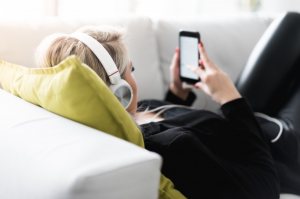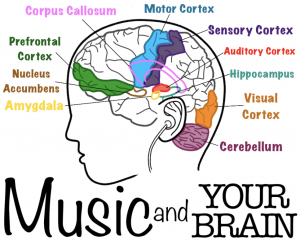Music and the Brain (Grades 8-12)
By SQ Outreach 2017-2018
Adapted to the Web by SQ Outreach 2019-2020

Today we’re going to learn about the different parts of the brain that are involved in music. Studies show that music is very powerful because a variety of areas are activated when you listen, perform, or move to music. By constantly activating all of these areas, you’re making more connections between your brain cells (neurons) and different parts of the brain. Connections between the left and right hemispheres of the brain is possible because of the corpus callosum.
Listening: When you hear something, sound waves travel into the ear, and eventually, this information will make its way to the auditory cortex. If the song has words, information can also be sent to language centers in the brain so that you can understand what you’re hearing.
Making Music: When you play music, you’re engaging a bunch of different senses. For example, if you’re reading music, your eyes send information to your visual cortex. Information about touch is also sent to your sensory cortex.
Moving: Moving to music requires many different areas in your brain. Your motor cortex is an important part for movement like playing an instrument, dancing, or even tapping or swaying to music. Your cerebellum is another part that’s involved in movement.
Feeling: Another activity that we might not think about doing with music but that we do all the time is reacting to it and making associations with it. Do we like it? What do we expect? How does it make us feel? What are we doing when we hear the music?
Parts of the brain that are associated with our emotional reaction to music (like whether it makes us happy, sad, etc.) are the amygdala and nucleus accumbens. When we hear music, we will also have certain expectations (like knowing the next word in the song) created by our prefrontal cortex. And the hippocampus is responsible for recalling certain memories.

Memory
Multisensory events, or events that engage more than one sense, are more vivid to us. Therefore, we will remember something that we both see and hear better than something that we only see. Some people have a better visual, auditory, or multisensory memory – it depends on the person.
Learning is also context dependent. If you are studying fish underwater, you will retain it better than you would on land because you have a hands-on experience with what you are learning.
Music or noise that has a steady, consistent rhythm can help you retain information since it is neutral and acts as a background noise as opposed to listening to songs with lyrics.
Memory Techniques
Mnemonic – Any memory trick that can help somebody remember information.
Common types of mnemonics-
- Acronyms – words or phrases where the letters stand for what you want to remember Example: “pemdas” or “Please Excuse My Dear Aunt Sally” stands for parentheses, exponents, division, multiplication, addition, subtraction
- Rhymes – a short phrase that helps us remember something Example: Spanish class “for how you feel and where you are, always use the verb estar”
- Chunking and Organizing– breaking things down into categories and then memorizing each category Example: colors, the alphabet, numbers
- Imagery- remembering something because you’ve seen it Example: we know plants are green because we see plants in our mind
- Sound Mnemonics – catchy songs that help us remember something Example: the alphabet
Try to come up with your own examples for all of the above categories.
Let’s use what you’ve learned!
Here is a list of terms and short definitions. Do you think you can memorize these in the next 10-15 minutes? We are going to use mnemonics that involve music to memorize this list in a very short amount of time.
Parts of the Brain:
-
- corpus callosum – connects the left side to the right side
- cerebellum – helps coordinate movements
- amygdala – involved in memory, emotion, and smell
- nucleus accumbens – reward center of the brain (bonus points for remembering that it is stimulated by music)
- prefrontal cortex – personality expression/ decision making
- hippocampus – center of emotion and memory
Try to choose a song that you know well. Use the chorus as the tune and change the words. (This will need a lot of enthusiasm, you gotta create a vibe!!!!!) Give yourself 5-10 minutes to write the song, then practice singing the song for 5 minutes. Next, sing the song without reading the lyrics.
Suggested songs: YMCA, Happy Birthday, Twinkle Twinkle Little Star, most pop songs……
For example, we wrote the following lyrics to the first verse and chorus of “Single Ladies” by Beyoncé.
cerebellum, hippocampus, nucleus accumbens (x2)
auditory cortex, visual cortex, corpus callo-osum
motor cortex, prefrontal cortex, and amygdala
If you like it then you use your amygdala (x2)
Don’t deny it when you use your auditory cortex
If you like it then you use your amygdala
Woah oh oh
This is another more advanced example from YouTube:
If you can sing your song without looking, Congrats!! You have hacked your memory!
In conclusion, while singing may not be for everyone, mnemonics help you memorize things faster in a relatively short period of time. The next time you are having trouble studying, feel free to have fun while studying and make up something catchy because you are more likely to remember the material whether you make a silly acronym, an artistic diagram, or a catchy song.
Sources:
http://brainworldmagazine.com/music-rhythm-and-the-brain/
https://effectsofmusicinquiry.weebly.com/music-and-the-brain.html
https://wp.unil.ch/discoverunil/2016/11/using-multiple-senses-to-improve-memory/
http://blogs.longwood.edu/lamusica/2013/05/01/mnemonics-using-music-to-memorize/
https://www.scientificamerican.com/article/bring-science-home-mnemonics/
https://psychcentral.com/lib/memory-and-mnemonic-devices/
https://www.scientificamerican.com/article/bring-science-home-mnemonics/
Image of girl with headphones:

